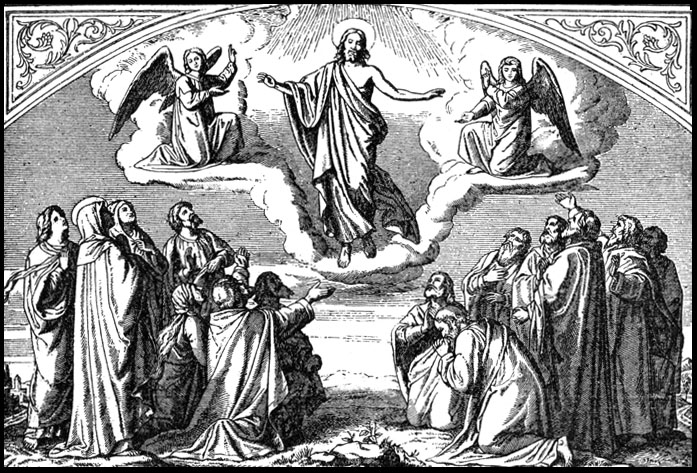Home l Liturgy & Sacraments l Liturgical Calendar
The Ascension
The second mystery of Paschaltide is the Ascension.

Doctrinal Note for the Ascension
The Ascension crowns the whole of our Lord’s life. Christ was now to take possession of the kingdom of heaven which He had won by His sufferings, and to open to us His Father’s house, “setting our frail nature at the right hand of God’s glory”, that there, as God’s children, we may fill the place from which the angel’s fell. So, as Conqueror of sin and Satan, Jesus enters heaver; while the angels hail and greet their King and the souls of the just, freed from Limbo, form for Him an escort of glory. “I go to prepare a place for you” He told His apostles. “There where the Head has entered,” says St. Leo, “the body also is called to penetrate.”
The triumph of Christ is the triumph of His Church. Like the High Priest who, under the Old Law, entered the Holy of Holies to offer the blood of the victims to almighty God, our Lord, the Apostle tells us, has entered the Holy of Holies of the heavenly Jerusalem, there to offer His own blood, the blood of the New Testament, and to obtain for us favors from God. It is on Ascension Day that Christ begins His heavenly priesthood, showing His glorious wounds to God. While it is the complement of all our Lord’s feasts, the Ascension is the fount of our sanctification. As the Church sings in the preface, “He was lifted up into heaven, so that He might make us partakers of His Godhead.”
Historical Note for the Ascension
Forty days after our Lord’s resurrection, the apostles, who had come to Jerusalem at the approach of Pentecost, were assembled in the Cenacle when our Lord appeared and took a last meal with them, afterwards leading them outside the city on the Bethany side to the Mount of Olives, the highest of the mountains which surround the capital. Then Jesus blessing His apostles was raised towards the sky.
This was at midday. Then a cloud hid Him from sight and two angels came and told the disciples that Jesus would return to earth at the end of the world.
On the Mount of Olives, on the spot where our Lord ascended into heaven, St. Helen built a basilica, after the pattern of that of the Holy Sepulcher. By a happily devised piece of symbolism, it was open to the sky. It was destroyed by the Mohammedans and replaced in the fourteenth century by a monument of mediocre style.
Liturgical Note for the Ascension
The feast of the Ascension was formerly not distinguished from Pentecost because Paschaltide was regarded as a single feast-day, beginning at Easter and ending with the descent of the Holy Ghost on the apostles. Before long the Ascension was kept on the fortieth day after the Resurrection, having its own vigil and octave. It is now a holy day of obligation which in some diocese (e.g. the Archdiocese of Seattle) is transferred to the following Sunday.
The symbolic ceremony peculiar to this feast, is the final extinction of the Paschal candle, whose light during these holy forty days has represented the presence of our Lord in the midst of His disciples. It is extinguished after the reading of the Gospel, which speaks to us of our blessed Lord’s departure into heaven.
The spirit of this feast is emphasized in the Collect, which shows us that having with liturgical cycle, followed our Lord through the whole course of His life, we must lift our gaze towards heaven, and dwell there by faith and hope, for it is the true fatherland of God’s children.
-St. Andrew’s Daily Missal
Copyright © 2015-2025 Saint Joseph Catholic Church, Latin Mass Parish, 602 S 34th St., Tacoma, WA 98418. All Rights Reserved.
Website comments or questions: info@saintjosephtacoma.org


